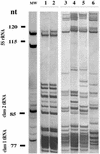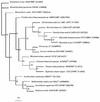A new species of Devosia that forms a unique nitrogen-fixing root-nodule symbiosis with the aquatic legume Neptunia natans (L.f.) druce - PubMed (original) (raw)
A new species of Devosia that forms a unique nitrogen-fixing root-nodule symbiosis with the aquatic legume Neptunia natans (L.f.) druce
Raul Rivas et al. Appl Environ Microbiol. 2002 Nov.
Abstract
Rhizobia are the common bacterial symbionts that form nitrogen-fixing root nodules in legumes. However, recently other bacteria have been shown to nodulate and fix nitrogen symbiotically with these plants. Neptunia natans is an aquatic legume indigenous to tropical and subtropical regions and in African soils is nodulated by Allorhizobium undicola. This legume develops an unusual root-nodule symbiosis on floating stems in aquatic environments through a unique infection process. Here, we analyzed the low-molecular-weight RNA and 16S ribosomal DNA (rDNA) sequence of the same fast-growing isolates from India that were previously used to define the developmental morphology of the unique infection process in this symbiosis with N. natans and found that they are phylogenetically located in the genus Devosia, not Allorhizobium or RHIZOBIUM: The 16S rDNA sequences of these two Neptunia-nodulating Devosia strains differ from the only species currently described in that genus, Devosia riboflavina. From the same isolated colonies, we also located their nodD and nifH genes involved in nodulation and nitrogen fixation on a plasmid of approximately 170 kb. Sequence analysis showed that their nodD and nifH genes are most closely related to nodD and nifH of Rhizobium tropici, suggesting that this newly described Neptunia-nodulating Devosia species may have acquired these symbiotic genes by horizontal transfer.
Figures
FIG. 1.
LMW RNA profiles of type species of fast-growing genera of bacteria from the family Rhizobiaceae that nodulate various legumes and of strains that nodulate N. natans: strain J1 (lane 1), strain J2 (lane 2), A. undicola LMG 11875T (lane 3), R. leguminosarum ATCC 10004T (lane 4), S. meliloti ATCC 3390T (lane 5), and M. loti ATCC 3669T (lane 6).
FIG. 2.
Comparative sequence analysis of 16S rDNA from strain J1 and representative related strains from GenBank. The significance of each branch is indicated by a bootstrap value calculated for 1,000 subsets. Bar, 4 nt substitutions per 100 nt.
FIG. 3.
Comparative sequence analysis of nodD gene sequences from strain J1 and representative related strains from GenBank. The significance of each branch is indicated by a bootstrap value calculated for 1,000 subsets. Bar, 5 nt substitutions per 100 nt.
FIG. 4.
Comparative sequence analysis of nifH gene sequences from strain J1 and representative related strains from GenBank. The significance of each branch is indicated by a bootstrap value calculated for 1,000 subsets. Bar, 5 nt substitutions per 100 nt.
FIG. 5.
(A) Plasmid profile in horizontal 0.7% agarose gel. Lanes: 1, D. riboflavina LMG2277T; 2, strain J1; 3, strain J2; MW, S. meliloti GR4. (B) Southern blot hybridization with the digoxigenin-labeled nodD probe. Lanes: 4, D. riboflavina LMG2277T; 5, strain J1; 6, strain J2. (C) Southern blot hybridization with the digoxigenin-labeled nifH probe. Lanes: 7, D. riboflavina LMG2277T; 8, strain J1; 9, strain J2.
Similar articles
- Description of Devosia neptuniae sp. nov. that nodulates and fixes nitrogen in symbiosis with Neptunia natans, an aquatic legume from India.
Rivas R, Willems A, Subba-Rao NS, Mateos PF, Dazzo FB, Kroppenstedt RM, Martínez-Molina E, Gillis M, Velázquez E. Rivas R, et al. Syst Appl Microbiol. 2003 Mar;26(1):47-53. doi: 10.1078/072320203322337308. Syst Appl Microbiol. 2003. PMID: 12747409 - Insights into the Phylogeny, Nodule Function, and Biogeographic Distribution of Microsymbionts Nodulating the Orphan Kersting's Groundnut [Macrotyloma geocarpum (Harms) Marechal & Baudet] in African Soils.
Mohammed M, Jaiswal SK, Dakora FD. Mohammed M, et al. Appl Environ Microbiol. 2019 May 16;85(11):e00342-19. doi: 10.1128/AEM.00342-19. Print 2019 Jun 1. Appl Environ Microbiol. 2019. PMID: 30952658 Free PMC article. - Emergence of β-rhizobia as new root nodulating bacteria in legumes and current status of the legume-rhizobium host specificity dogma.
Hassen AI, Lamprecht SC, Bopape FL. Hassen AI, et al. World J Microbiol Biotechnol. 2020 Feb 24;36(3):40. doi: 10.1007/s11274-020-2811-x. World J Microbiol Biotechnol. 2020. PMID: 32095903 Review. - Allorhizobium undicola gen. nov., sp. nov., nitrogen-fixing bacteria that efficiently nodulate Neptunia natans in Senegal.
de Lajudie P, Laurent-Fulele E, Willems A, Torck U, Coopman R, Collins MD, Kersters K, Dreyfus B, Gillis M. de Lajudie P, et al. Int J Syst Bacteriol. 1998 Oct;48 Pt 4:1277-90. doi: 10.1099/00207713-48-4-1277. Int J Syst Bacteriol. 1998. PMID: 9828428 - Changing concepts in the systematics of bacterial nitrogen-fixing legume symbionts.
Sawada H, Kuykendall LD, Young JM. Sawada H, et al. J Gen Appl Microbiol. 2003 Jun;49(3):155-79. doi: 10.2323/jgam.49.155. J Gen Appl Microbiol. 2003. PMID: 12949698 Review.
Cited by
- Ecological shifts in soil microbiota and root rot disease progress during ginseng monoculture.
Cho G, Kim DR, Kwak YS. Cho G, et al. Front Microbiol. 2024 Oct 18;15:1442208. doi: 10.3389/fmicb.2024.1442208. eCollection 2024. Front Microbiol. 2024. PMID: 39493853 Free PMC article. - Comparing Sediment Bacterial Communities of Volcanic Lakes and Surrounding Rivers in Inner Mongolia Autonomous Region, Northeastern China.
Chao J, Li J, Gao J, Bai C, Tang X, Shao K. Chao J, et al. Microorganisms. 2024 Jul 15;12(7):1435. doi: 10.3390/microorganisms12071435. Microorganisms. 2024. PMID: 39065203 Free PMC article. - Back to the future: Using herbarium specimens to isolate nodule-associated bacteria.
Petipas RH, Antoch AA, Eaker AA, Kehlet-Delgado H, Friesen ML. Petipas RH, et al. Ecol Evol. 2024 Jul 14;14(7):e11719. doi: 10.1002/ece3.11719. eCollection 2024 Jul. Ecol Evol. 2024. PMID: 39011130 Free PMC article. - Tea and Pleurotus ostreatus intercropping modulates structure of soil and root microbial communities.
Yang Z, Qu J, Qiao L, Jiang M, Zou X, Cao W. Yang Z, et al. Sci Rep. 2024 May 17;14(1):11295. doi: 10.1038/s41598-024-61883-w. Sci Rep. 2024. PMID: 38760401 Free PMC article. - OsCIPK2 mediated rice root microorganisms and metabolites to improve plant nitrogen uptake.
Chen M, Feng S, Lv H, Wang Z, Zeng Y, Shao C, Lin W, Zhang Z. Chen M, et al. BMC Plant Biol. 2024 Apr 16;24(1):285. doi: 10.1186/s12870-024-04982-0. BMC Plant Biol. 2024. PMID: 38627617 Free PMC article.
References
- Bergersen, F. J. 1961. The growth of Rhizobium in synthetic media. Austr. J. Biol. 14:349-360.
- Chen, W. M., S. Laevens, T. M. Lee, T. Coenye, P. de Vos, M. Mergeay, and P. Vandamme. 2001. Ralstonia taiwanensis sp. nov., isolated from root nodules of Mimosa species and sputum of a cystic fibrosis patient. Int. J. Syst. E vol. Microbiol. 51:1729-1735. - PubMed
- Cruz-Sánchez, J. M., E. Velázquez, P. Mateos, and E. Martínez-Molina. 1997. Enhancement of resolution of low molecular weight RNA profiles by staircase electrophoresis. Electrophoresis 18:1909-1911. - PubMed
- de Lajudie, P., E. Laurent-Fullele, A. Willems, U. Torck, R. Coopman, M. D. Collins, K. Kersters, B. Dreyfus, and M. Gillis. 1998. Allorhizobium undicola gen. nov., sp. nov., nitrogen-fixing bacteria that efficiently nodulate Neptunia natans in Senegal. Int. J. Syst. Bacteriol. 48:1277-1290. - PubMed
Publication types
MeSH terms
Substances
LinkOut - more resources
Full Text Sources
Molecular Biology Databases




